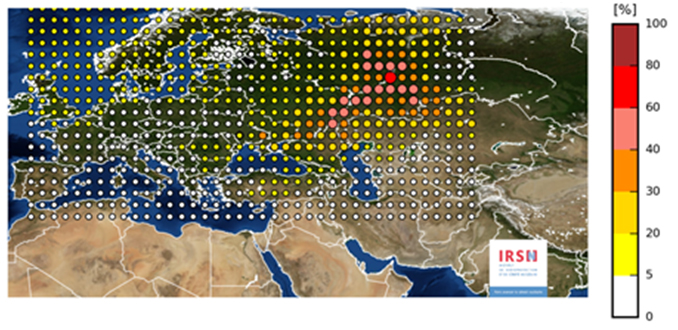
A mysterious cloud of radioactive material that hovered over Europe last month came from Russia, Russian weather monitoring data released today (Nov. 21) suggests.
The spike in radioactivity was caused by a substance called ruthenium-106. But what, exactly, is ruthenium-106, does it pose risks to human health and how did it get into the air?
History of radioactive cloud
Member countries of the International Atomic Energy Agency, an international organization that promotes peaceful use of nuclear energy, detected the radioactive isotope ruthenium-106 hovering above 14 European countries in early October, according to a statement from France's Nuclear Safety Authority. Based on radioactivity levels across the continent, experts suspected the origin was somewhere in Russia Russia denied a nuclear accident occurred. [Images: Chernobyl, Frozen in Time]
Today, however, the Russian Meteorological Service said it detected "extremely high contamination" with ruthenium-106 above the southern Ural Mountains in September. In Argayash, levels of ruthenium-106 were 986 times normal levels in late September, according to Rosgidromet, the weather monitoring service.
Nuclear-fuel byproduct
Ruthenium-106 is a radioactive isotope of ruthenium, meaning it has a different number of neutrons than the naturally occurring form of the element. The hard, white metal is chemically similar to platinum, and can be produced by dissolving platinum in nitric acid and hydrochloric acid. Ruthenium is incredibly rare and was discovered in 1844 in the Ural Mountains, Live Science previously reported.
Ruthenium-106, however, is not found naturally, according to France's Nuclear Safety Authority. Instead, it is typically produced by the nuclear fission, or splitting, of uranium-235 atoms in nuclear reactors. Ruthenium-106 is also often produced during the reprocessing of nuclear fuel. Nuclear reprocessing involves separating the radioactive plutonium and uranium from spent nuclear fuel from nuclear power reactors, according to the Union of Concerned Scientists.
Ruthenium-106 is also used in head and eye radiation cancer treatments, according to the Journal of Radioanalytical and Nuclear Chemistry. It is also found in trace levels in satellites, as part of their thermoelectric generators, according to the Institut de Radioprotection et de Sûreté Nucléaire (IRSN), a French institute focusing on radiological and nuclear risks.
Sign up for the Live Science daily newsletter now
Get the world’s most fascinating discoveries delivered straight to your inbox.
High doses of ruthenium are toxic and carcinogenic when ingested. The material is strongly retained in the bones. However, the levels detected over the past two months seem to be safe, according to the IRSN.
"The concentration levels of ruthenium-106 in the air that have been recorded in Europe and especially in France are of no consequence for human health and for the environment," the IRSN said in a statement.
While food might be contaminated with ruthenium for several miles around the epicenter of the nuclear release, the chance that contaminated food will be exported is also low, the IRSN said.
Likely source
The radioactive cloud didn't contain any other nuclear waste products, ruling out the possibility that the spike came directly from a nuclear reactor, according to the French Nuclear Safety Authority.
Given that ruthenium-106 has no natural source and no one reported fallen satellites in the region, the likeliest source for the toxic cloud is an uncontrolled release of nuclear material, the Nuclear Safety Authority said.
Just 19 miles (30 kilometers) from the Argayash weather station is the Mayak Production Association in Chelyabinsk Oblast, which reprocesses nuclear fuel for radioactive material used in research and industry, according to the Straits Times, a Singapore-based media outlet.
However, Rosatom, the state nuclear agency that runs the Mayak plant, denied any involvement.
"The contamination of the atmosphere with ruthenium-106 isotope registered by Rosgidromet is not linkedto the activity of Mayak," Rosatom officials said in a statement. "The measurements which Rosgidromet has released suggest that the dose people might have received is 20,000 times less than the allowed annual dose and presents no threat at all to health."
The Mayak facility has experienced past nuclear accidents. In 1957, for instance, the world's third biggest nuclear accident, called the Kyshtym disaster, exposed hundreds of thousands of people nearby to radioactive contamination. The two biggest nuclear disasters occurred at the Chernobyl Power Plant in Ukraine and the Fukushima Daiichi Nuclear Power Plant in Japan, respectively.
Originally published on Live Science.

Tia is the managing editor and was previously a senior writer for Live Science. Her work has appeared in Scientific American, Wired.com and other outlets. She holds a master's degree in bioengineering from the University of Washington, a graduate certificate in science writing from UC Santa Cruz and a bachelor's degree in mechanical engineering from the University of Texas at Austin. Tia was part of a team at the Milwaukee Journal Sentinel that published the Empty Cradles series on preterm births, which won multiple awards, including the 2012 Casey Medal for Meritorious Journalism.









